Clobazam addiction: causes, symptoms, treatments, and risk factors
Table of content
- What is Clobazam addiction?
- What are the causes of Clobazam addiction?
- What are the signs of Clobazam addiction?
- What are the symptoms of Clobazam addiction?
- What are the dangers of Clobazam addiction?
- What are the available treatments for Clobazam addiction?
- How is Clobazam addiction prevented?

Clobazam addiction pertains to the progression towards a state of reliance on the benzodiazepine medication clobazam. The hallmark aspect of the illness is an overwhelming desire to consume the substance, which leads to the development of both physical and psychological dependence.
The causes of clobazam addiction include prescription dosage and duration, genetic factors, psychological factors, environmental factors, tolerance development, self-medication, and avoidance of withdrawal.
The symptoms of clobazam addiction include a persistent desire to use the drug, mood shifts, hostile behavior, slowed or shallow breathing, slurred speech, and blurred vision.
The risk factors for clobazam addiction are genetics, co-occurring mental health disorders, a history of substance use disorder, easy access to clobazam, and societal and peer pressures.
What is Clobazam addiction?
Clobazam addiction encompasses a complex pattern of physical and psychological dependence on the medication clobazam. While most benzodiazepines act as complete agonists to gamma-aminobutyric acid (GABA) A receptors, clobazam only partially binds to these sites.
Since it binds less strongly to the GABA-A (alpha1-beta2g2) receptor (BZ-1), it produces less sedation, according to a continuing education activity titled, “Clobazam” by Humayun et al., published in Statpearls.
A research article by Carlos A.M. Guerreiro published in the August 2014 issue of the Indian Journal of Medical Research states that in 2011, clobazam was approved by the U.S. Food and Drug Administration (FDA) as a supplemental treatment for adults and children two years of age and older who have seizures related to Lennox-Gastaut syndrome.
Benzodiazepine addiction involving clobazam is caused by the body gradually adapting to the drug, resulting in growing tolerance and the requirement for higher doses to get the same therapeutic effects. Furthermore, while attempting to lessen or discontinue clobazam use, individuals may experience withdrawal symptoms, continuing the cycle of dependence.
How common is Clobazam addiction?
Clobazam addiction is common, with about 36% of people acquiring tolerance to the medication, with the precise percentage varying from 0% to 86% contingent upon the study one is examining, according to a 1986 review by M.M. Robertson published in Epilepsia.
This is owing, in part, to the fact that tolerance is defined differently across studies. The study also added that it is impossible to anticipate which patients will experience this condition or when.
In general, a 2019 study by Maust et al., published in Psychiatric Services found that the United States has a larger rate of benzodiazepine use than originally estimated, with misuse accounting for about 20% of total use.
What are the causes of Clobazam addiction?
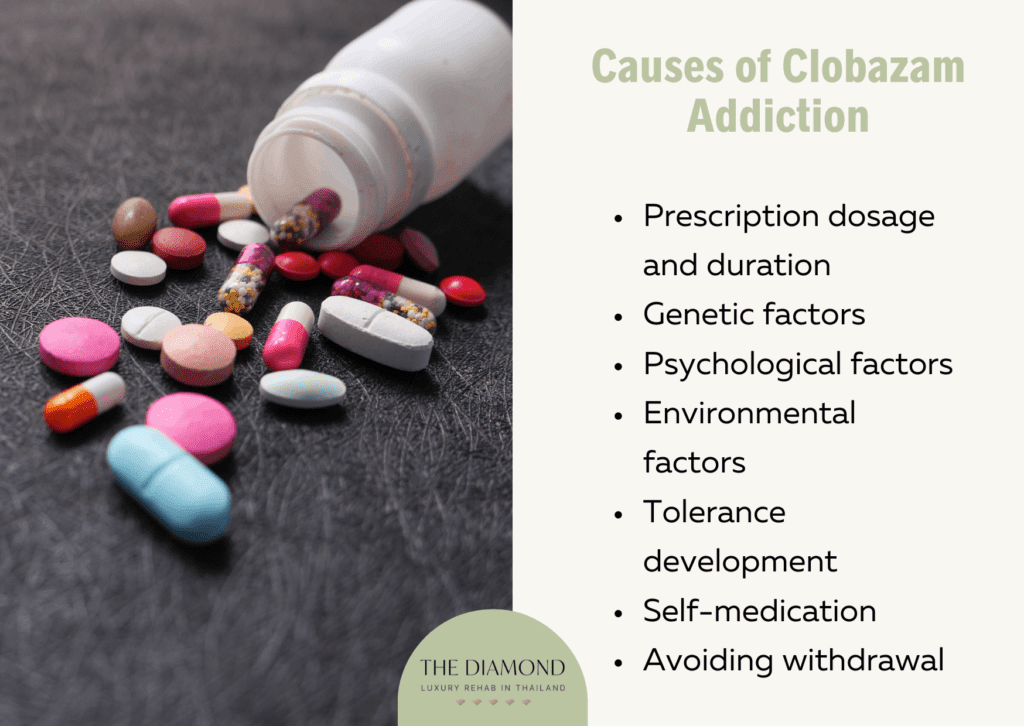
The causes of clobazam addiction are multifaceted and involve a combination of physiological, psychological, and environmental factors. The causes of clobazam addiction are listed below.
- Prescription dosage and duration
- Genetic factors
- Psychological factors
- Environmental factors
- Tolerance development
- Self-medication
- Avoiding withdrawal
1. Prescription dosage and duration
Prescription dosage and duration refer to the recommended amount of medication and the length of time for which it should be taken, as determined by a healthcare professional. In the case of clobazam, adherence to prescribed dosage and duration is crucial to minimize the risk of addiction.
For instance, according to the 2023 drug information on clobazam (oral route) from Mayo Clinic, seizures in adults and children over the age of 2 who weigh more than 30 kg require a doctor-determined average dose that is weight-based. Typically, 10 milligrams (mg) divided into two daily doses is the beginning point.
Healthcare providers typically prescribe an initial dose based on the patient’s medical condition, and adjustments may be made over time. However, deviations from the prescribed dosage, such as self-adjustments or exceeding recommended limits, can contribute to the development of addiction.
2. Genetic factors
Genetic factors refer to the heritable traits and characteristics that are determined by an individual’s genetic makeup, which is the combination of genes inherited from their biological parents.
An article titled, “Clobazam” last revised in 2021 by MedlinePlus states that due to their genetic composition, certain individuals may react differently to clobazam. A blood test may be ordered by your doctor to determine the appropriate clobazam dose for you.
More importantly, according to a 2019 article written by Laura Dean for Medical Genetics Summaries, several essential pharmaceuticals, including antidepressants, antiplatelet medicines, proton pump inhibitors, and benzodiazepines like clobazam, are metabolized by the CYP2C19 gene.
The levels of N-desmethylclobazam, the active metabolite of clobazam, will be elevated in individuals who are poor CYP2C19 metabolizers. As a result, patients who are known as CYP2C19 poor metabolizers should begin with a dose of 5 mg daily and gradually increase it based on their weight.
3. Psychological factors
Mental and emotional components that impact the thoughts, emotions, and actions of an individual are known as psychological factors. Psychological factors significantly contribute to the development and maintenance of substance dependence in the context of clobazam addiction.
The medication’s calming effects may provide a perceived solution to psychological distress, leading individuals to use it as a coping mechanism. Moreover, psychological factors like a lack of effective coping strategies, low resilience to stress, or difficulties in managing emotions can contribute to a reliance on clobazam for emotional regulation.
4. Environmental factors
Environmental factors refer to the external influences and circumstances that surround an individual and can impact their development, behaviors, and choices. In the case of clobazam addiction, these factors contribute significantly to the risk and progression of substance dependence.
Social influences within an individual’s environment, such as peer pressure or the normalization of substance use, can play a role in shaping attitudes toward clobazam.
Additionally, a lack of a strong support system or exposure to environments with high levels of stress may increase the likelihood of seeking solace in medications like clobazam. Accessibility to the drug, either through prescription practices or availability in the community, also constitutes an environmental factor influencing addiction.
5. Tolerance development
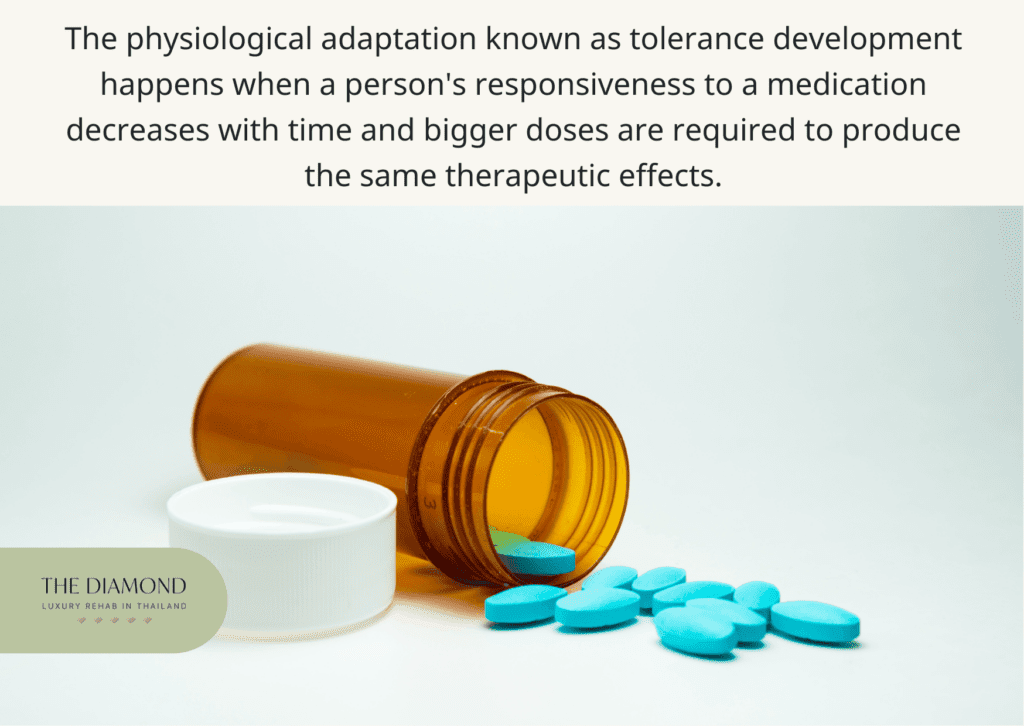
The physiological adaptation known as tolerance development happens when a person’s responsiveness to a medication decreases with time and bigger doses are required to produce the same therapeutic effects.
Initially, individuals prescribed clobazam may experience the desired calming effects at a specific dosage. However, continued use can lead to the body’s adjustment to the presence of the drug, resulting in a diminished response.
To maintain the desired effects, individuals may be tempted to increase their dosage without medical guidance. This escalation can inadvertently intensify the risk of dependence, as higher doses contribute to neuroadaptations in the brain’s neurotransmitter systems.
In the case of benzodiazepines like clobazam, drug tolerance emphasizes the need to carefully monitor prescribed usage. This is very important to lower the risk of dependence and the adverse consequences that come with it.
6. Self-medication
Self-medication refers to the practice of individuals using medications, including prescription drugs, without the guidance or supervision of a healthcare professional to alleviate perceived symptoms or cope with various issues.
The desire for quick solutions to emotional or psychological distress may lead individuals to misuse clobazam as a means of self-soothing. This self-initiated usage frequently involves going against recommended dosages or time frames, which raises the risk of tolerance and dependence.
A lack of medical supervision may also lead to a lack of knowledge about possible adverse effects, drug combinations, and the possibility of addiction.
7. Avoiding withdrawal
Avoiding withdrawal refers to the conscious or unconscious efforts made by individuals to prevent or alleviate the symptoms associated with discontinuing or reducing the use of a substance, such as clobazam.
A study by Tolbert et al., published in the April 2012 issue of Neurology stated that the most common adverse effects after abruptly stopping clobazam were tremor, anxiety, insomnia, and headache.
These withdrawal symptoms can be distressing and challenging to endure. The fear of experiencing these symptoms may drive individuals to continue using clobazam, even when there might be a clinical rationale for reducing or discontinuing the medication.
What are the risk factors for Clobazam addiction?
Risk factors for clobazam addiction include a variety of characteristics that raise the possibility that certain groups of people will become dependent on the drug. The most common risk factors for clobazam addiction are listed below.
- Genetics: According to a 2022 article titled, “Clobazam (Monograph)” written by the American Society of Health-System Pharmacists (ASHP) for Drugs.com, clinical and pharmacodynamic responses to clobazam may be influenced by CYP2C19 genetic polymorphism. The main enzyme involved in the metabolism of clobazam’s pharmacologically active metabolite, N-desmethylclobazam, is CYP2C19. N-desmethylclobazam plasma concentrations are higher in individuals with limited CYP2C19 metabolism than in those with extensive CYP2C19 metabolism.
- Co-occurring mental health disorders: More than one in every four persons suffering from severe mental illness also has a substance abuse issue, according to a 2023 article titled, “Mental Health and Substance Use Co-Occurring Disorders” from the Substance Abuse and Mental Health Services Administration. The article also states that there is a higher incidence of substance use problems like clobazam addiction in individuals with certain mental health conditions, such as anxiety disorders, depression, personality disorder, and schizophrenia.
- A history of substance use disorder: A 2016 article on clobazam from the Cardiology Associates of Northern New York cautions against sharing clobazam with anybody, particularly those who have a history of drug misuse or addiction, and states that the medication has the potential to become habit forming.
- Easy access to clobazam: Easy access can lead to the sharing or selling of the medication, facilitating its misuse in individuals for whom it was not prescribed. The lack of medical supervision and the ability to obtain clobazam without a legitimate medical need contribute to a higher risk of escalating doses, development of tolerance, and ultimately, an increased potential for abuse and dependence.
- Societal and peer pressures: Addiction to clobazam is also significantly influenced by environmental factors. Social circles and friendships can influence perceptions of acceptable behaviors, including the use of medications. If peers normalize or encourage the use of clobazam, individuals may be more likely to initiate or continue its use, sometimes inappropriately.
Why is using Clobazam addictive?
Clobazam can be addictive because it falls under the benzodiazepine category, a group of medications recognized for their ability to create both physical and psychological dependence. Its addictive nature stems from its effects on the central nervous system.
As a benzodiazepine, clobazam enhances the effects of the neurotransmitter GABA, resulting in a soothing and tranquilizing reaction. These effects can be psychologically reinforcing, and individuals may find relief from stress or anxiety through the sedative effects of the medication.
How addictive is Clobazam?
Clobazam is highly addictive to the extent that it exposes its users to the dangers of misuse, addiction, and abuse, all of which can result in overdose or death, according to the highlights of prescribing information on clobazam – clobazam tablet last revised in February 2023 by Breckenridge Pharmaceutical, Inc.
This is why the article also points out that counseling regarding the risks and appropriate usage of Clobazam tablets, especially in high-risk patients, is necessary. Additionally, monitoring for signs of abuse, misuse, and addiction is recommended.
How long does it take to become addicted to Clobazam?
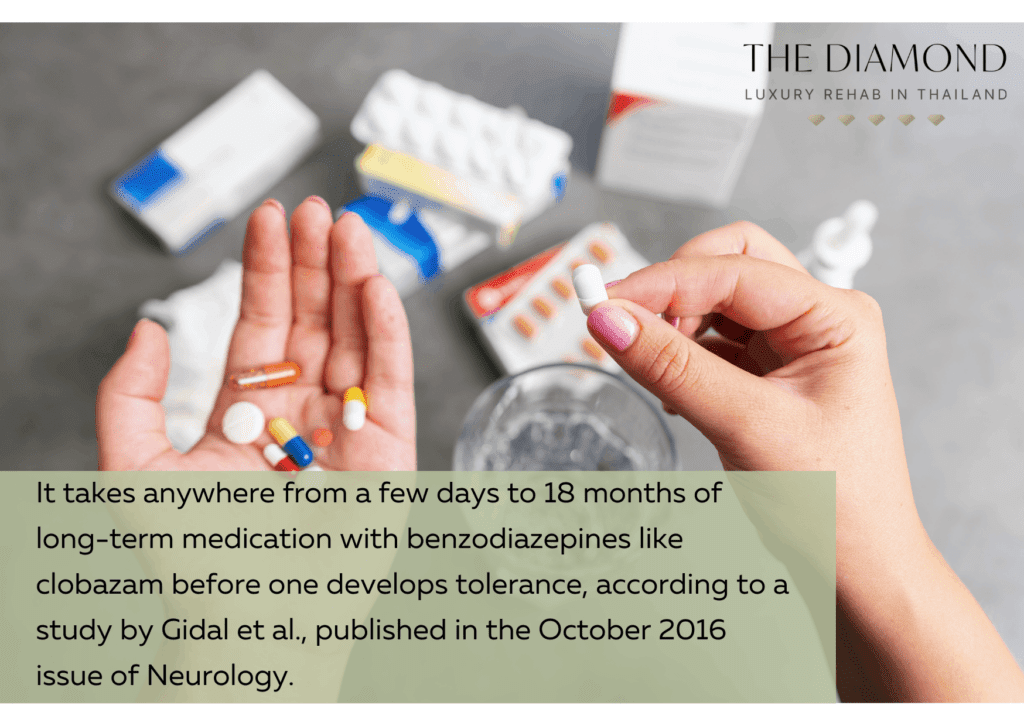
It takes anywhere from a few days to 18 months of long-term medication with benzodiazepines like clobazam before one develops tolerance, according to a study by Gidal et al., published in the October 2016 issue of Neurology.
Tolerance and addiction frequently go hand in hand, since one can lead to the other. The study went on to say that most reports show tolerance developing after using benzodiazepines continuously for one to six months.
What are the signs of Clobazam addiction?
The signs of clobazam addiction include a variety of behavioral, psychological, and physical manifestations that point to a possible drug dependency. The signs of clobazam addiction are listed below.
- Escalating doses: An escalation in the dosage of clobazam beyond prescribed limits can be a significant sign of addiction. Patients may autonomously increase their doses in an attempt to intensify the calming effects, indicating a loss of control over medication use.
- Tolerance development: A greater degree of tolerance may develop in those who are addicted to clobazam; consequently, higher doses may be necessary to attain equivalent therapeutic effects. When the prescribed dosage gradually becomes inadequate and the patient requests dosage adjustments, this may become evident.
- Abandoning once-enjoyed activities in favor of drug use: When individuals prioritize the use of clobazam over activities they previously found pleasurable or fulfilling, it suggests a shift in priorities that is characteristic of substance dependence. Clobazam, as a benzodiazepine, can have sedative effects, and if individuals are consistently choosing the drug over activities they used to enjoy, it may indicate a growing reliance on the medication for emotional regulation or avoidance of discomfort.
- Drug use that keeps someone from meeting important responsibilities: Prioritizing clobazam use rather than attending to vital chores at home, at work, or with one’s family is indicative of an individual’s struggle to maintain a clean slate. Disregard for one’s duties can cause problems at work and damaged relationships, which in turn affect other areas of their lives negatively.
- Using the substance in unsafe situations (driving, drinking): Clobazam use in risky circumstances, like when operating a motor vehicle or performing tasks requiring attentiveness, is a strong indicator of addiction. Due to its sedative properties, clobazam may slow down mental processes, motor skills, and response times. Using the medication when these skills are essential not only shows a lack of concern for one’s own safety but also a lack of self-control when it comes to drug use.
- Feeling the effects of withdrawal when cutting back on use: Withdrawal symptoms, such as anxiety, insomnia, and irritability, occur when the body has become accustomed to the presence of the drug and reacts negatively when its use is reduced.
What are the symptoms of Clobazam addiction?
Symptoms of clobazam addiction include a variety of observable physical, behavioral, and psychological markers that indicate a person may be battling with prescription dependence. The symptoms of clobazam addiction are listed below.
- Persistent desire to use the drug: A persistent desire to use clobazam, even in the absence of clear medical necessity, can signal addiction. Patients might express an intense craving for the drug and may prioritize obtaining and using it over other aspects of their health and life.
- Mood shifts: According to an article on clobazam last updated in October 2023 by The Epilepsy Foundation, if the dose is steadily increased over time, small changes in mood (such as irritation, depression, or diminished motivation) or difficulties such as impaired memory may go unrecognized or be accepted as normal for that person.
- Hostile behavior: A 2018 review by Carol Paton published by the Cambridge University Press states that a decrease in the restraining effect of the cortex may result from the inhibition of neurotransmission induced by benzodiazepines; this may manifest as hostility, agitated toxic psychosis, heightened anxiety, and rage.
- Slowed or shallow breathing: As a CNS depressant, clobazam may cause delayed or shallow breathing. GABA inhibits neuron activation, resulting in a calming effect. While this feature can help with conditions like anxiety and seizures, it can also cause respiratory depression when taken in large doses or combined with other CNS depressants like opioids or alcohol.
- Slurred speech: Slurred speech becomes indicative of a potential issue when observed consistently and in conjunction with other signs of addiction, such as changes in behavior, neglect of responsibilities, and an increasing tolerance to the medication.
- Blurred vision: One typical side effect of several antiepileptic medications like clobazam is visual problems. Blurred vision, diplopia, and nystagmus are examples of non-specific retino- and neurotoxic visual impairments that are frequently linked to overdosage and chronic use of antiepileptic drugs (AEDs), according to a 2004 study by Hilton et al., published in Seizure: European Journal of Epilepsy.
How is Clobazam addiction diagnosed?
Clobazam addiction is diagnosed with the use of a comprehensive assessment conducted by healthcare professionals. A thorough medical history is first dealt with, which includes details on the patient’s past drug use and clobazam usage.
Medical professionals must also conduct thorough behavioral and psychological evaluations to identify any changes in behavior (such as avoiding duties or participating in harmful activities) and any mental health issues (such as increased worry or persistent drug cravings).
Slow reflexes or coordination problems are examples of the kinds of symptoms that could be identified during a physical exam. Additionally, withdrawal symptoms, when attempting to cut back on clobazam use, can be indicative of physical dependence.
Laboratory tests may be employed to assess the levels of clobazam in the individual’s system and rule out the presence of other substances. The diagnosis is typically based on the collective evidence of these assessments, and the healthcare provider may collaborate with mental health professionals to determine the severity of addiction and plan an appropriate treatment approach.
Finally, to diagnose clobazam addiction, medical professionals may utilize the Diagnostic and Statistical Manual of Mental Disorders, Fifth Edition (DSM-5) diagnostic criteria for benzodiazepine use disorder. An article written by Tae Woo Park last updated in 2022 by UpToDate states that at least two of the following criteria need to be observed within a period of 12 months.
To begin, sedatives, hypnotics, or anxiolytics are frequently used in greater quantities or for longer periods of time than prescribed. Second, individuals may have a persistent urge or make futile attempts to reduce or restrict their use of these substances.
Furthermore, significant time is spent on activities associated with obtaining, using, or recuperating from the effects of sedatives, hypnotics, or anxiolytics. Another requirement is craving, or a strong desire or drive to consume these substances.
Repeated usage that results in a failure to perform major role obligations, repeated social or interpersonal problems, and giving up or limiting important activities as a result of substance use are also taken into account.
Moreover, using sedatives, hypnotics, or anxiolytics in physically dangerous conditions, as well as continuing to use despite being aware of potential bodily or psychological difficulties, contribute to the diagnosis. The occurrence of tolerance and withdrawal symptoms adds to the identification of a potentially harmful pattern of substance use.
Where can you seek Clobazam addiction diagnosis?
A diagnosis of clobazam addiction can be sought from a number of medical providers and treatment facilities. Usually, medical professionals such as general practitioners, psychiatrists, or addiction specialists make the diagnosis of clobazam addiction.
To talk honestly about your problems, it’s advised to make an appointment with a mental health expert or your primary care physician. Healthcare professionals will probably perform a comprehensive examination during the assessment, which may include behavioral observations, a full medical history, and even laboratory testing to determine the amount of clobazam in your system.
For a more comprehensive assessment, speaking with addiction specialists may be advised in certain circumstances. Consulting with medical professionals for a diagnosis guarantees a thorough comprehension of the condition and expedites the creation of a suitable treatment strategy.
Several types of treatment facilities can also assist in diagnosing and addressing clobazam addiction, providing specialized care and support. For instance, outpatient facilities offer diagnostic assessments and treatment for individuals struggling with substance use, including clobazam addiction.
These centers provide flexibility for individuals to attend sessions while still managing daily responsibilities. On the other hand, inpatient or residential rehabilitation centers provide a more focused and organized setting for medical diagnosis and treatment.
Individuals receive 24/7 care, including medical supervision, counseling, and support to address addiction comprehensively. Clinics specializing in addiction psychiatry also have professionals with expertise in both mental health and substance use disorders. They can conduct thorough assessments, diagnose addiction, and provide appropriate treatment plans.
What are the dangers of Clobazam addiction?
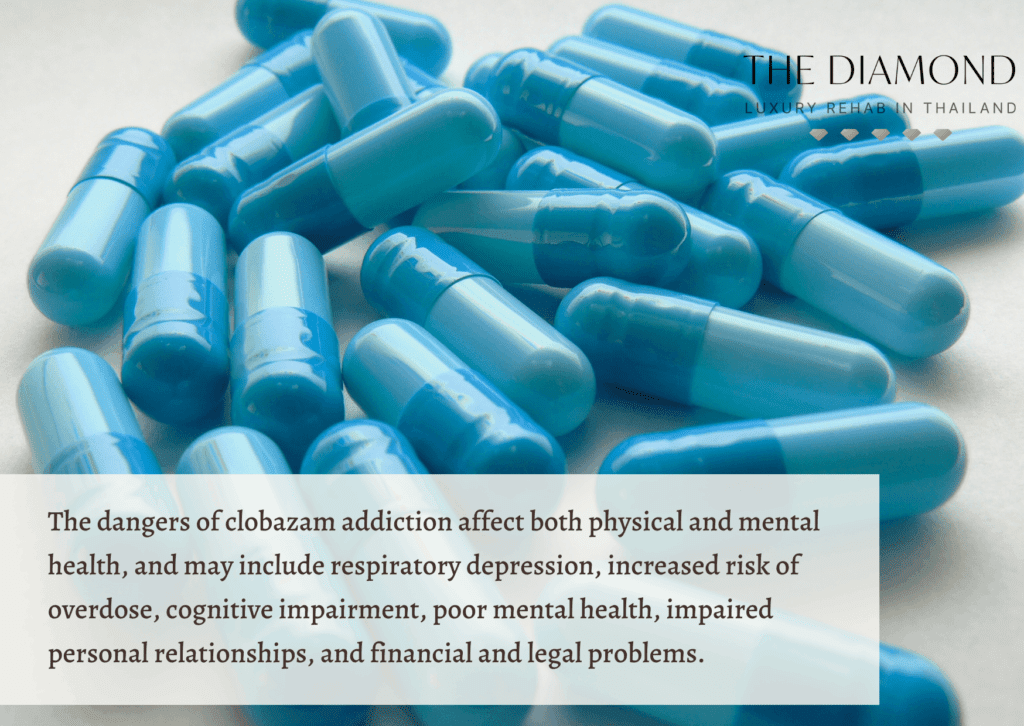
The dangers of clobazam addiction affect both physical and mental health, and may include respiratory depression, increased risk of overdose, cognitive impairment, poor mental health, impaired personal relationships, and financial and legal problems.
First off, clobazam, a benzodiazepine, has sedative qualities that may cause respiratory depression. This is a severe worry that, if left untreated, might have fatal effects. The potential risks are further raised by the increased chance of overdose, particularly when mixed with other depressive substances like alcohol or opioids.
Prolonged usage can impair cognitive function, decreasing memory, focus, and general mental clarity, in addition to the immediate physical concerns. A person may go through withdrawal symptoms when they cut down or quit drinking or taking drugs. Due to these side effects, they may feel compelled to use the substance more frequently, which is detrimental to their health. Lastly, an addiction to clobazam can cause problems in relationships, at work, financially, and legally.
Is Clobazam a high-risk medication?
Yes, clobazam is considered a high-risk medication due to its classification as a benzodiazepine. In fact, according to a drug information titled, “Clobazam – Oral” last revised in February 2023 on HealthLink BC, overdose and death can occur from clobazam abuse and addiction, as it does with other benzodiazepines.
Furthermore, an article on Onfi last updated in May 2023 on RxList stated that a study that looked at 199 placebo-controlled clinical trials found that people who took antiepileptic drugs (AEDs), like Onfi, which is a brand name for clobazam, had a higher risk of suicidal thoughts or actions.
It is well-known that clobazam, like other benzodiazepines, can induce tolerance, dependence, and withdrawal symptoms. Impairment in cognitive and psychomotor abilities may result from the sedative effects of these drugs on the central nervous system.
The potential for negative consequences is increased due to the risk of misuse, particularly when elevating dosages or combining with other substances. Additionally, abrupt discontinuation of clobazam can lead to withdrawal symptoms, reinforcing the need for careful management and supervision.
How does Clobazam addiction impact mental health?
Clobazam addiction can significantly impact mental health, leading to a range of adverse effects, including cognitive decline, poor memory and attention, and development or exacerbation of mental health conditions.
Clobazam has sedative effects as a benzodiazepine, which can lead to cognitive impairment by impairing memory, attention, and overall mental clarity. Prolonged use might aggravate or worsen mental health issues like anxiety and depression.
The use of clobazam to deal with emotional difficulties may impede the development of healthier coping strategies, creating a cycle of dependency. Furthermore, the danger of withdrawal symptoms, such as increased anxiety and irritability, can put further burden on an individual’s mental health.
Addiction can also lead to isolation, damaged relationships, and difficulties performing tasks, therefore the influence on mental health is frequently entangled with social and vocational implications.
What are the symptoms of Clobazam withdrawal?

The symptoms of clobazam withdrawal include anxiety, irritability, sleep disturbances, confusion, headache, seizures, tremors, restlessness, muscle pain, palpitations, panic attacks, and hallucinations.
According to a 2023 article written by Cerner Multum for Drugs.com, if you abruptly stop taking the medication after taking it for a long time, you can experience more seizures or potentially fatal withdrawal symptoms. In certain cases, withdrawal symptoms can linger for a year or more.
What are the available treatments for Clobazam addiction?
Available treatments for clobazam addiction include a range of therapeutic strategies and approaches aimed at treating clobazam dependence. The available treatments for clobazam addiction are listed below.
- Detoxification
- Behavioral therapy
- Medication for addiction treatment (MAT)
- Gradual tapering
- Support groups
- Dual diagnosis treatment
- Aftercare and relapse prevention
1. Detoxification
Detoxification, commonly known as detox, is a medical process aimed at managing the withdrawal symptoms associated with discontinuing substance use, in this case, clobazam.
For individuals dealing with clobazam addiction, detox serves as an initial step in the treatment process. Clobazam, being a benzodiazepine, has the potential to induce physical dependence; discontinuing use abruptly may give rise to withdrawal symptoms such as agitation, sleep disturbances, and restlessness.
Detoxification is conducted under medical supervision to ensure safety and comfort during this challenging phase. The purpose of detox is to prepare clients for ongoing addiction therapy as well as to handle the immediate physical effects of withdrawal.
2. Behavioral therapy
Behavioral therapy aims to change unhelpful habits and encourage more positive thought and behavior patterns. Behavioral therapy is an essential component of clobazam addiction treatment since it addresses the psychological aspects of dependence.
Therapists assist people in recognizing and altering the attitudes, feelings, and actions that lead to addiction. Cognitive-behavioral therapy (CBT), a common form of behavioral therapy, is particularly effective for clobazam addiction.
In fact, according to a 2021 study by Chapoutot et al., published in the International Journal of Environmental Research and Public Health, one significant benefit of employing (CBT) to address benzodiazepine (BZD) addiction is its ability to target not only the addiction per se, but also the underlying conditions—specifically, insomnia and anxiety—that precipitated the BZD use.
By addressing the underlying factors that prompted the prescription of BZD, individuals improve their prospects of successfully ceasing usage.
3. Medication for addiction treatment (MAT)
Medication for addiction treatment (MAT) refers to a comprehensive approach to addiction treatment that combines the use of medications with counseling and behavioral therapies.
In the context of clobazam addiction, MAT may involve the use of certain medications to help manage the withdrawal symptoms, reduce cravings, and support individuals in achieving and maintaining abstinence.
While there isn’t a specific FDA-approved medication exclusively for clobazam addiction, certain medications used for benzodiazepine dependence may be considered.
For instance, according to a 2015 research article titled, “Management of benzodiazepine misuse and dependence” published in the Australian Prescriber, withdrawal from benzodiazepines like clobazam can be partially mitigated with anticonvulsants, provided the patient does not exhibit narcotic dependence on other substances.
The efficacy of carbamazepine is moderate, while pregabalin has demonstrated some degree of success. Finally, as a GABAA receptor antagonist, flumazenil has been administered subcutaneously or intravenously at a low dose for four days. This is done to facilitate a rapid, symptom-free withdrawal from benzodiazepines to a lower dose or abstinence.
4. Gradual tapering

Gradual tapering is a therapeutic approach involving the systematic reduction of medication dosage over a controlled period. When it comes to treating clobazam dependence, this method is often employed to manage withdrawal symptoms and facilitate a safer and more comfortable transition to abstinence.
A 2023 drug label information titled, “Clobazam tablet” last updated in October 2023 on DailyMed states that in order to mitigate the potential for withdrawal reactions, increased frequency of seizures, and status epilepticus, it is advisable to reduce the dosage of clobazam tablets or discontinue their use gradually.
The total daily dose should be tapered by 5 to 10 mg per week until the medication is discontinued. In the event that a patient experiences withdrawal reactions, one might consider either discontinuing the tapering regimen or restoring the dosage to the level at which it was initially tapered.
5. Support groups
Support groups are therapeutic communities where people who are going through the same things can meet with others who understand what they’re going through. Members can provide each other advice, support, and ways to cope.
Those struggling with clobazam addiction can benefit greatly from attending a support group where they can talk to people who have been through similar experiences. Sharing one’s experiences with others in a supportive community develops a sense of belonging and eliminates the isolation that is frequently linked with addiction.
Across the spectrum of recovery phases—from detoxification to long-term abstinence—individuals can offer invaluable perspectives, practical guidance, and emotional comfort. The camaraderie and understanding gained from participation in support groups complement other treatment modalities.
6. Dual diagnosis treatment
Dual diagnosis treatment refers to an integrated approach in mental health care that addresses both substance use disorders and co-occurring mental health conditions simultaneously.
Misuse of clobazam can exacerbate or coexist with mental health issues such as anxiety or depression. Dual diagnosis treatment acknowledges the interrelated nature of substance use and mental health by offering comprehensive care that addresses both.
People who are addicted to clobazam get individualized treatments like medication, psychotherapy, and behavioral therapies that help with their underlying mental health problems.
7. Aftercare and relapse prevention
Aftercare and relapse prevention are essential components of comprehensive addiction treatment. Both of these elements offer continuous support and ways to maintain recovery from addiction.
Aftercare refers to the supportive services and interventions provided to persons after they have completed the first phase of addiction treatment, such as inpatient or outpatient programs. This could involve ongoing counseling, participation in support groups, and regular consultations with healthcare practitioners.
Relapse prevention is designed to create coping skills and ways to prevent relapse after attaining initial sobriety. In order to maintain recovery from clobazam dependence, aftercare and relapse prevention are of the utmost importance, given the risk of relapse and the possibility of experiencing withdrawal symptoms.
These methods provide ongoing support, which helps people deal with the problems they face in daily life without using clobazam.
When should you seek treatment for Clobazam addiction?
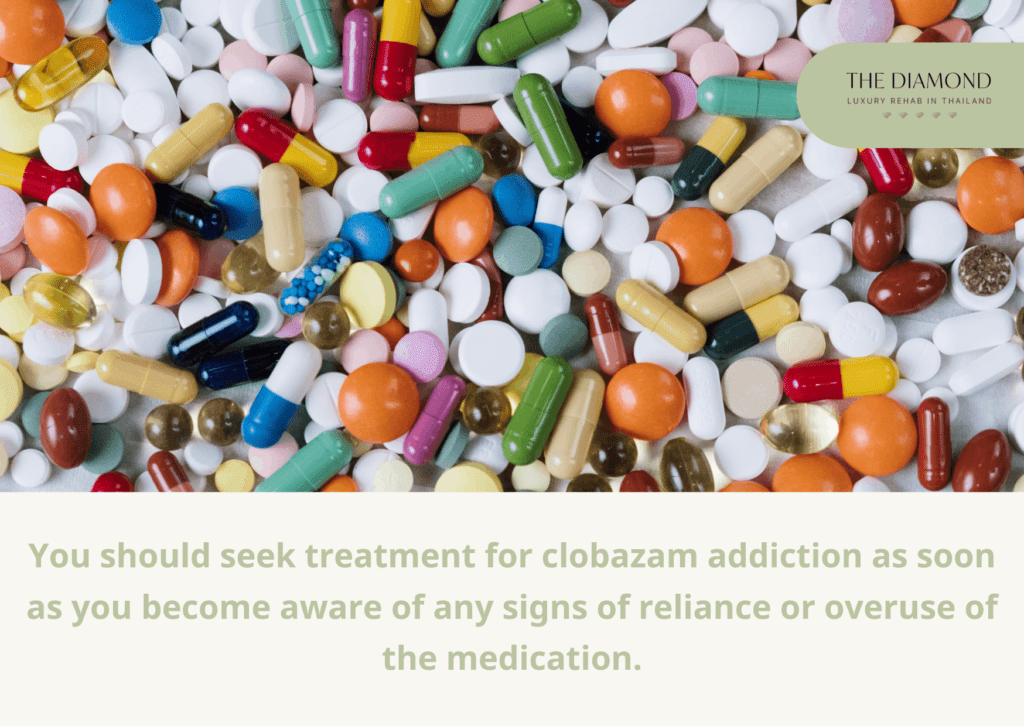
You should seek treatment for clobazam addiction as soon as you become aware of any signs of reliance or overuse of the medication. If you find yourself consistently taking clobazam in larger amounts than prescribed, experiencing cravings, or struggling to control your use, it is advisable to seek professional help.
Additionally, if the medication is negatively impacting your daily life, relationships, or work responsibilities, these are further indicators that treatment is warranted. Early intervention can prevent the progression of addiction, minimize potential health risks, and improve the chances of a successful recovery.
Can Clobazam addiction be treated without medication?
Yes, clobazam addiction can be treated without medication. Behavioral therapies, counseling, and support groups play a central role in non-medication-based treatments for clobazam addiction.
Cognitive-behavioral therapy (CBT) and contingency management help people notice and change negative thought patterns, build coping techniques, and treat underlying addiction-related concerns.
People struggling with addiction might find a safe place to process their emotions in counseling and learn new ways to cope. Non-medication-based treatments focus on empowering individuals to make positive lifestyle changes, enhance resilience, and build a foundation for sustained recovery from clobazam addiction.
A case report by Khong et al., on benzodiazepine dependence published in the November 2004 issue of the Australian Family Physician indicated that the nonpharmacological treatment of insomnia and anxiety can be beneficial in cases of BZD dependence.
How is Clobazam addiction prevented?
Clobazam addiction can be prevented through a combination of awareness, responsible medical practices, and individual self-monitoring. As a key part of prevention, healthcare providers must carefully consider when benzodiazepine drugs like clobazam are needed, write prescriptions wisely, and regularly check patients for signs of dependence.
Patients can contribute to prevention by openly communicating with their healthcare providers, following prescribed dosages, and reporting any concerns about medication use promptly. Education about the potential risks of benzodiazepine use, including the risk of dependence, should be a part of patient-provider discussions.
Can offering alternative therapies prevent the need for Clobazam use?
Yes, offering alternative therapies can contribute to preventing the need for clobazam use. One way to achieve this goal is to provide people with alternatives to pharmaceuticals for dealing with symptoms that could otherwise necessitate the use of benzodiazepines.
When it comes to treating anxiety, stress, and sleep disturbances—issues that can cause epilepsy and necessitate the use of the medication clobazam—alternative therapies including yoga, mindfulness meditation, cognitive-behavioral therapy, and biofeedback may be helpful.
Can healthcare providers limit Clobazam prescriptions to prevent addiction?

Yes, healthcare providers can limit clobazam prescriptions to prevent addiction. Healthcare professionals can help reduce the risk of dependence and misuse by recommending benzodiazepines like clobazam with caution.
When deciding whether such drugs are necessary, providers can perform in-depth evaluations and, if suitable, take non-pharmacological approaches and alternative therapies into account.
They can also regularly monitor patients, analyze their reaction to the medicine, and reassess the need for long-term treatment. Addiction risk can be further reduced by putting into practice standards for responsible prescription, which include limitations on dosage and length of usage.


